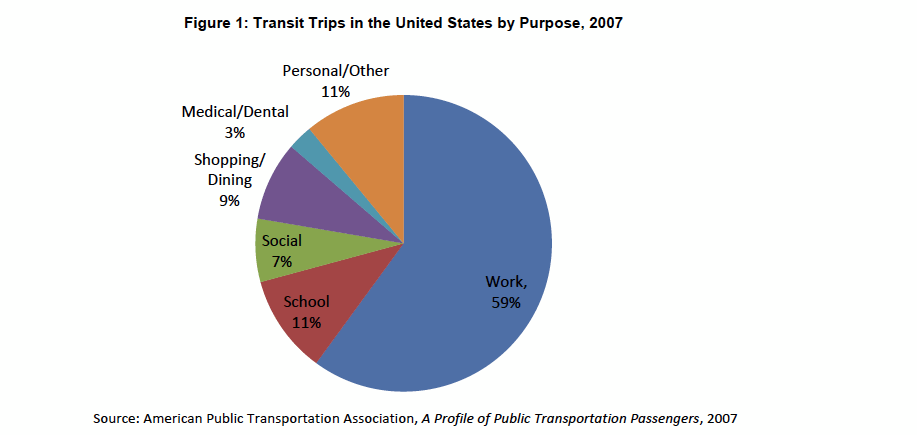CENTER FOR TRANSIT-ORIENTED DEVELOPMENT
Executive Summary
Historically, many regional transit systems were designed in a “hub and spoke” pattern, focusing on moving residents from relatively low-density residential communities to a single high-density employment center – typically the region’s historic central business district (CBD). In general, these systems have worked well for those workers with jobs in central cities. The effectiveness of this kind of system hinges directly on the density of the jobs co-located in close proximity to each other and within a short distance of transit stations.
Although CBDs and downtowns remain important regional employment locations, American cities have experienced significant decentralization over the last 60 years, as job centers have shifted from urban downtowns to suburban communities. This “employment sprawl” has helped to generate much of the traffic congestion experienced across regions today, contributing to over 100 billion dollars in lost time and fuel every year.1 In addition to traffic congestion, there are other important impacts to the dispersal of jobs, such as increased infrastructure costs, the loss of open space, and an increased average distance between homes and jobs. Many low income workers are cut off from expanding auto-oriented suburban employment concentrations because they do not own cars, and there are few transit options to get to these low density job centers. Even middle income workers who live in the suburbs and own cars are affected by the high cost of driving to work every day. This condition is likely to worsen in many regions as gas prices rise and absorb an increasing share of a household’s resources that could otherwise be spent on health care, education, child care, and even healthy food.
A stronger integration between land use and transportation planning can counter many of these problems by providing enhanced, lower-cost mobility options for residents and workers. For the past two decades, many planners and advocates have promoted “transit-oriented development” as a key strategy for achieving more sustainable and equitable land use patterns. Transit-oriented development (TOD) planning has generally been more focused on the origin side of the trip, conceived as dense residential neighborhoods and mixed-use development featuring housing built over retail. However, given that concentrated employment uses have been found to be more closely associated to transit ridership than dense residential uses, 2 it is clear that employment uses are a key component of the TOD equation. Even for today’s multi-nucleated regions, job centers that are clustered along major urban travel corridors have strong potential to support enhanced transit. Furthermore, the transformation of single-use suburban job centers to compact, mixed-use districts also offers the opportunity for shifting travel habits for mid-day convenience trips in addition to the commute trip.
This paper is a broad-based exploration of the relationship between transit and job concentrations in evolving regions, in order to emphasize the importance of the destination side of the trip for both transit operations and land use planning in station areas. The report is organized into three sections. Following the introduction in Section I, Section II describes the connection between employment and transit. In Section III, the paper examines employment decentralization patterns and their implication for transit and TOD. Section IV explores three case study regions using geo-spatial analytical tools, to understand how regions with multiple job centers, including traditional CBDs and suburban nodes, can take advantage of existing concentrations to bolster transit ridership and foster employment-based TOD.
The following are major themes emerging from the analysis of employment patterns and the relationship to transit:
Employment dispersal patterns in the United States have been significant over the past 20 years, but these patterns have taken different forms in various regions. In each of the case study regions examined in this paper, high-density job clusters have emerged outside of the central business district, often along freeways and highways, creating multi-nucleated regions.
Many of the higher density employment centers with potential to support transit ridership are located in suburban contexts, such as Buckhead in Atlanta and Scottsdale Airpark in Phoenix. In some cases, the total employment in these suburban employment centers rivals the central business district (CBD). These places may be important places to consider in regions considering future investments in transit expansions.
Higher density employment centers are often appropriate places to consider introducing other types of land uses in order to create a mixed-use transit district with a wide variety of amenities, thereby providing a greater array of mobility options for residents and workers.
Because the link between employment and transit has not been central to the TOD discussion, the implications of spatial job patterns has generally not been a focal point of transit planning. The findings of this paper suggest that land use patterns associated with employment uses must become an important part of the ongoing dialogue on the integration of transportation and land use planning moving forward.
Download full version (PDF): Transit-Oriented Development (TOD) and Employment
About the Center for Transit-Oriented Development
“The Center for Transit-Oriented Development is the only national nonprofit effort dedicated to providing best practices, research and tools to support market-based transit-oriented development. The Center for TOD is a joint venture with Reconnecting America, the nonprofit Center for Neighborhood Technology, an urban policy and GIS center based in Chicago; and Strategic Economics, an urban economics firm in Berkeley.”
Tags: CBD, Center for Transit Oriented Development, CTOD, Transit-Oriented Development







 RSS Feed
RSS Feed